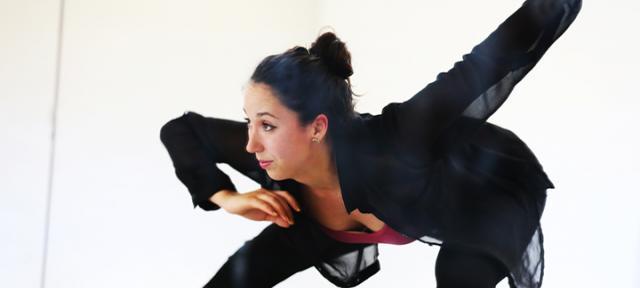'Movement as an Intervention' with Miriam King

Hampshire first caught my eye when I was searching for schools that would allow me to study both neuroscience and dance.
Dancing is how I express myself—I love being able to move and connect with people without verbal communication. I really love performing dance: something beautiful happens when an audience witnesses and then finds meaning in moving bodies, in a shared space, in relationship with the music.
Neuroscience is also my passion, the intricacy of our brains. Our brains control how we perceive the world and how we move.
Hampshire enabled me to combine my two passions. My Division III project consisted of a choreography project and a written component titled Movement as an Intervention for Neurodegenerative Disorders (M.I.N.D.). I wrote my thesis incorporating a mixed-methods approach to research with Dance for Parkinson’s classes and movement interventions for people with Huntington’s disease.
Influencing my Div III was my work over nine months with UMass Dance Professor Paul Dennis to develop movement interventions for Huntington’s patients at a clinic in Tewksbury, Massachusetts. I also connected with Hampshire alumna Fritha Pengelly, the teacher of Dance for Parkinson's in Northampton, and had a great experience attending her classes.
I completed the Dance for PD® teacher-training workshop at the Mark Morris Dance Group in Brooklyn, New York, last summer and plan to start a Dance for Parkinson’s class in Columbus, Ohio, this summer. These dance classes allow people to creatively express themselves, empower them to move in new ways, and offer tools to continually develop a greater sense of body awareness. I’m so inspired by the wonderful dancers who take these classes and the positive impact, which is evident.
The unity and connection I witnessed in Dance for Parkinson’s classes was a main source of inspiration for my Div III. I collaborated with fellow Div III student Ayliffe Brown to create wearable technology, LED costumes, in hopes of communicating this concept through a collaborative dance/technology performance piece.
The Earl Ubell Science Award, as well as a grant from the Foundation for Psychocultural Research–Hampshire College Program in Culture, Brain, and Development, made it financially possible for me to complete the Dance for Parkinson’s teacher training and execute my Div III. I’m also so thankful for my faculty committee, Neil Stillings and Daphne Lowell, who guided me through the whirlwind that we call Division III.
Miriam King teaches a Dance for Parkinson’s class at The Ohio State University Columbus and is training and performing with OYO Dance, an up-and-coming company based in Columbus.



